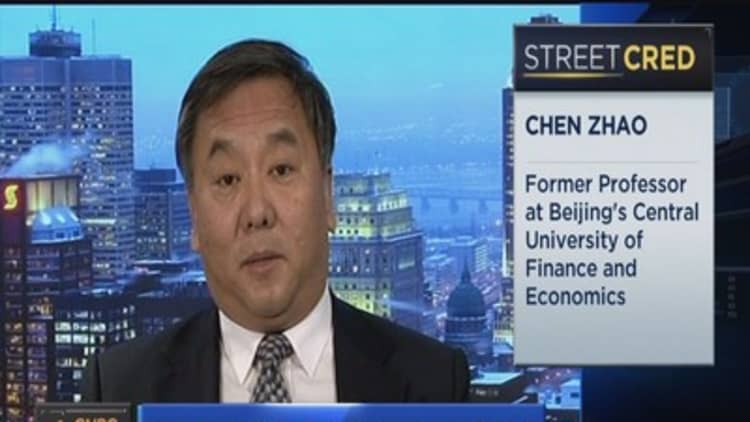


Chinese markets extended an already rough start to the year Monday, losing further ground after another sell-off in late afternoon trade that sent mainland indexes down more than 5 percent.
The tumbled 168 points, or 5.29 percent, to 3,017.99, while the Shenzhen composite plunged 130.61 points, or 6.6 percent, to close at 1,848. In afternoon trade, Hong Kong's index closed down 2.7 percent, slipping below the 20,000 threshold for the first time since June 2013.
The rest of Asia also closed down, with Australia's main ASX 200 index continued its downward slide, ending 58.63 points, or 1.17 percent, lower at 4,932.20. The energy, materials and financials sectors weighed, with those indexes down 1.8, 2.95, and 1.27 percent respectively.
In South Korea, the Kospi shed 22.78 points, 1.19 percent, to close at 1,894.84 on Monday's session, with commodities sectors seeing early losses.
Mainland brokerages suffered steep losses, with shares down as much as 9 percent at market close. Citic Securities' mainland-listed shares were off 7.01 percent, while its Hong Kong-listed ones fell 3 percent. Airlines stocks on the mainland traded mixed, between up 3.72 and down 1.54 percent. Airlines tend to see an earnings boost when oil prices fall.
Beijing guides the yuan higher
On Monday the People's Bank of China (PBOC) guided the yuan higher by setting the mid-point fix at 6.5626 against the dollar. On Friday, the midpoint was fixed at 6.5636. The yuan at 6.5818 against the dollar.
The yuan-based Hong Kong Interbank Offered Rates (Hibor) spiked to over 13 percent from 4 percent Friday as offshore yuan volume declined.
Last week, the Shanghai Composite lost all of its 2015 gains, falling by 9.97 percent in just five days. Trading in Chinese markets was halted twice last week by circuit breakers - a market-calming regulatory tool - that were only implemented in the country at the start of the week.
The circuit breakers were designed to trigger a 15-minute trading halt if the CSI 300 index fell 5 percent. If that index moved by 7 percent, trade was halted for the rest of the session. By the end of the week, China suspended its circuit breakers, but investors remained wary over the country's ability to handle financial turmoil.
Experts said the ongoing crisis in Asia's largest economy would have bigger, broader implications about the region's economic prospects.
Taimur Baig, chief economist for Asia at Deutsche Bank Research, said in a note on Friday, "The key risk is China, where fears of continued economic slide are causing capital outflows, exchange rate depreciation, asset market selloff, and policy dilemmas."
Baig noted that while this might not halt economic growth in the mainland, with large parts of the economy operating independently of the country's stock markets, it would hurt sentiment -- not just in China, but also in rest of Asia, causing possible deflation, credit crunches and policy challenges.
Aussie drop a double-edged sword
The Australian dollar fell below 70 U.S. cents again, trading at $0.6969.
Paul Bloxham, chief economist for Australia and New Zealand at HSBC, said in a note that this was the third time since the global financial crisis that the Aussie had fallen below 70 U.S. cents.
But a weaker Aussie was not necessarily negative for Australia's economy, Bloxham said, because it could help to offset the lower commodity prices that were hitting local income growth and speed up the economy's rebalancing toward non-mining sectors.
Commodities remain a concern
Energy plays in Asia traded in the red, weighed by further declines in oil prices. U.S. crude futures were down 2.02 percent at $32.49 a barrel, after falling 10.47 percent in the previous week. Globally traded Brent futures were down 2.18 percent at $32.80 a barrel; last week, Brent futures shed 10 percent.
Australian oil stocks Santos, Oil Search and Woodside Petroleum closed down between 0.76 and 5.03 percent.
In China, mainland oil stocks were down between 2.31 and 3.63 percent, while Hong Kong-traded CNOOC, Petrochina, and Sinopec shares had losses of between 2.97 and 4.91 percent.
Resource stocks were also down, pressured by lower commodity prices.
Rio Tinto and BHP Billiton, Australia's two biggest miners, shed 3.34 and 4.89 percent respectively, while iron ore producer Fortescue saw losses of 4.93 percent. Iron ore prices were down at $41.50 a tonne a tonne Friday, for a total 3 percent decline for the week after rallying for three weeks.
Samsung drops on missed targets
Elsewhere, in South Korea, shares of heavyweight Samsung Electronics were down 1.62 percent after the company missed its profit targets for the fourth quarter of 2015 last week. Other blue chip stocks such as SK Hynix also traded lower.
Shares of Doosan were down 0.49 percent after the company said its subsidiary sold 305 billion won ($252.71 million) worth of shares in fighter jet manufacturer Korean Aerospace Industries, according to reports.
Shares of Korean Aerospace Industries closed down 4.42 percent.
On Wall Street last week
In the U.S., major indexes closed the first trading week of the year in the red as global economic concerns outweighed an above-expectation jobs number for December.
The lost 6.1 percent for the week, closing at 16,346.45. The S&P 500 shed 5.96 percent for the week, down at 1,922.03 while the was down 7 percent at 4,270.78.
In Japan, the market will be closed for a public holiday.


